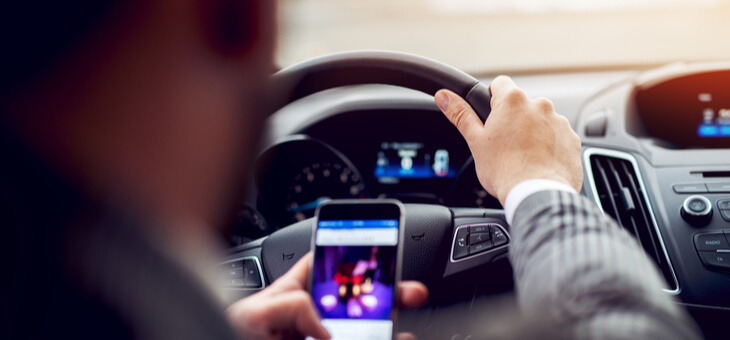Driving is a complex and demanding discipline. Drivers have to make hundreds of situational assessments and decisions every second they’re behind the wheel, and the consequences of getting it these wrong are seen every night on the news.
Cars today are equipped to help drivers avoid potentially dangerous situations, but the volume of information being relayed to the driver can, in itself, become a distraction.
There are three basic forms of distraction:
- visual distraction (taking your eyes off the road)
- manual distraction (taking one or both hands off the wheel)
- cognitive distraction (losing concentration on driving).
Any one of these factors adds to the time it takes you to perceive and react to an event, and that delay can be the difference between avoiding a crash or being involved in one.
What are the most dangerous distractions when driving?
Any distraction is dangerous when you’re in control of a vehicle.
These include:
- texting or dialling a mobile phone
- reading or writing
- reaching for an object
- being distracted by objects or people outside the vehicle
- browsing the internet
- adjusting devices within the vehicle such as the touchscreen, climate control or sound system
- eating or drinking.
Read: Top five mistakes made by older drivers
What effect does a distraction have?
Driving should command your full attention. Taking on a secondary task while driving can have a profound effect on your driving performance.
When your reaction time to critical safety events is increased:
- you might miss traffic signals or warnings
- you become less effective at staying within your lane
- your speed will vary
- you will travel too close to (or too far from) a vehicle ahead
- you will become less efficient at scanning and assessing the road environment.
Why do we take the risk?
We’ve all indulged in one or more distracting events when driving, and most of the time, it doesn’t have disastrous consequences. For instance, how often have you suddenly thought to yourself, ‘I don’t remember some (or all) of what happened in the last few kilometres of driving?’
Consequently, we often don’t see such behaviours as being dangerous (humans are notoriously poor at assessing risk). But as they say in the financial ads, past performance is no guarantee of future returns.
It only takes one combination of factors for your distraction to result in a potentially dangerous crash, because even a small increase in the time it takes you to react can be critical.
Read: Should you spend extra money on premium fuel?
A study of crashes in Victoria and NSW between 2000 and 2011 found driver distraction to be a contributory factor in 16 per cent of injury crashes resulting in at least one hospitalisation. The real figure for all crashes (from minor to fatal) is undoubtedly much higher.
What to do to avoid distractions when driving
Drivers can be distracted by the most insignificant things and the outcome can be horrific.
There are a number of steps you can take to minimise distractions:
- Plan your trip to ensure you don’t travel when you are tired or when you’d normally be asleep.
- Take positive actions to remove the temptation to be distracted by your mobile phone. Turn it off, or switch it to silent. Put it out of reach (even in the boot, if necessary) or, if you have a passenger, give him/her the phone to manage during the trip. Use smartphone settings and apps to stop the phone alerting you to incoming phone calls, texts or notifications. iPhone, for example, has a setting called ‘Do not disturb while driving’. Android has similar apps that can be installed and automatically activated when the phone is moving at a certain speed. You can deactivate these apps if you are a passenger in a moving car.
- Don’t forget your smartwatch. Turn off or silence text messages, notifications or alerts, or take it off and put it out of reach.
- It is still astounding that people don’t wear their seatbelts. Ensure yours is fastened and check that your passengers are also belted in.
- If you have a pet in the car, make sure it is secured.
- Ensure your seat, the mirrors, climate control, sound system and navigation are all set up for your journey, and if any need adjustment pull over in a safe place before making the change.
- Keep your sunglasses somewhere where you can quickly reach them if required.
- Leave the application of lipstick, make-up or any other personal grooming until you have stopped the vehicle.
- Create a calm and focused environment.
- While driving, keep your eyes on the road, your hands on the wheel and your mind on the road.
- Continually and repeatedly check ahead for potential hazards.
Being aware of distractions is one of the best ways to avoid them. Most things you might want to do in a car can wait until it is safe to carry them out, and that’s not when the vehicle is moving (or stationary at a traffic light).
Ignoring distractions is a matter of having the right attitude and concentrating, to the exclusion of all else, on your driving.
Have you been guilty of driving while distracted’ Has someone who was driving while distracted caused you as problem? What’s the worst instance you’ve seen? Why not share your experience in the comments section below?
This article was first published on seniordriveraus.com and is republished with permission.
If you enjoy our content, don’t keep it to yourself. Share our free eNews with your friends and encourage them to sign up.

